Scott Voltage eRIDE Review | Feels Like You On Your Best Day
A featherweight eMTB with stealthy looks and one of the most natural-assist motors we’ve ever tested.
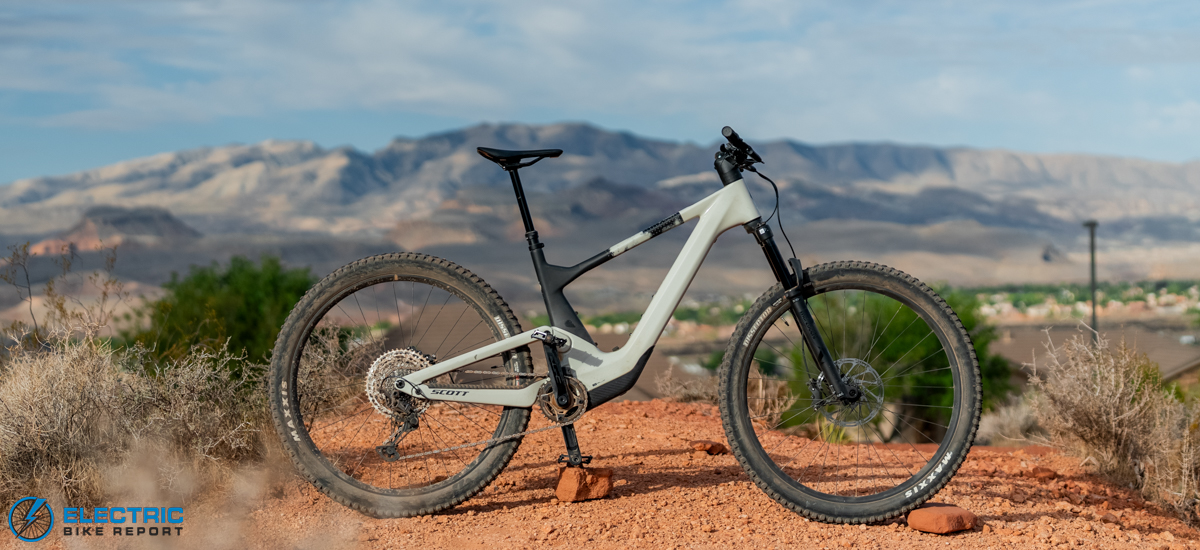
The Scott Voltage eRIDE 920 is proof that yesterday’s top tech can still be a killer buy — especially now that clearance pricing is hitting. Built around Scott’s Carbon HMF frame and powered by TQ’s ultra-compact HPR50 motor with a 360Wh battery, this eMTB barely hints at its electric side. Park it next to the analog Scott Genius and you’ll need a sharp eye to spot the difference.
That subtlety extends to the ride. TQ’s harmonic pin-ring drive delivers whisper-quiet support that mirrors your own effort, helping you climb and cover ground at a “podium pace” without losing the feel of a classic mountain bike. At just 41.5 lbs (size L), it’s one of the lightest full-suspension eMTBs we’ve tested, staying lively through berms and composed over downhill chatter.
A 150mm Marzocchi Z2 fork, Fox Float rear shock (tucked inside Scott’s Integrated Suspension Technology), and clean internal routing complete the sleek package — with only a slight servicing trade-off for all that hidden hardware.
Bottom line: if you’re looking to match your best riding days while sneaking in a few extra laps, the Voltage eRIDE 920 is hard to beat.
 Pros
Pros- Natural, realistic assist: The TQ HPR50 motor blends with your effort so well you almost forget it’s electric—until you notice how much faster you’re moving.
- Whisper-quiet drive: Thanks to its harmonic pin-ring design, the motor runs far more quietly than belt-and-gear systems.
- Featherweight build: At just 41.5 lbs (size L), the Voltage is among the lightest eMTBs we’ve tested, making handling and agility a breeze.
- Clean, stealthy look: Frame-integrated suspension, hidden cables, and a discreet motor/battery create a sharp, minimal aesthetic.
- Supportive suspension: The 150/150 mm setup feels balanced and supportive, while TwinLoc lets you firm or lock it out for climbs or flowy sections.
- Efficient battery use: Strong range for a 360 Wh pack, with the option to add a 160 Wh extender for ~44% more capacity.
- Well-rounded spec: Tires, brakes, and drivetrain all perform well out of the box—no urgent upgrades needed.
 Cons
Cons- Maintenance access: The hidden shock and internal cables keep things tidy but can make DIY service more involved.
- Fixed battery: The non-removable design bucks the trend toward swappable packs, limiting quick changes or easy charging off the bike.
- Battery: TQ Internal 360Wh, Range Extender Ready
- Charger: TQ 100-240V-4A
- Display: TQ HPR
- Motor: TQ HPR50 Mid Motor drive 50Nm max, 250W nominal, 300W max
- Pedal Assist:
- App:TQ
- UL Certification:
- Claimed weight: 42.55 lb
- Tested Weight: 41.5 lb
- Quoted height range: 5’5” – 6’5”
- Total payload capacity: 282 lbs
- Brakes:SRAM DB8 4 Piston Disc, SRAM Centerline CL Rotors F&R 200mm
- Fenders:Marzocchi Z2 Air Rail, 150mm travel, 15x110mm QR axle / tapered steerer, 44mm offset / Reb. Adj. / Lockout, SCOTT TwinLoc 2 Technology
- Shock:FOX Float Custom EVOL Performance, Travel 155mm
- Linkage:Virtual 4 Link kinematic
- Frame: Carbon HMF, Integrated Suspension Technology, Adjustable head angle
- Drivetrain: Shimano XT RD-M8100 SGS, Shadow Plus / 12-speed, FSA Alloy crankset / 175mm / 34T, Shimano CS-M6100 / 10-51 T
- Grips: Syncros Endurance lock-on grips
- Saddle: Syncros Tofino 2.0 Regular
- Seatpost: Syncros Duncan Dropper Post 1.5S, S size 140mm / M size 180mm / L & XL size 210mm
- Handlebar: Syncros Hixon 2.0 Alloy 6061 D.B., 12mm Rise / back sweep 8° / 780mm
- Cranks: 170 – 175mm
- Wheels: Syncros X-30S / 32H / 30mm / Sleeve Joint, Tubeless ready
- Tires: F/R: Maxxis Dissector / 29×2.6″ / 60TPI Wire Bead, EXO, Dual.
- Hubs: Formula CL-811 / 15x110mm front, Formula CL-148M / 12x148mm rear
- Spokes: Stainless Black 15G / 1.8mm
| S | M | L | XL | |
|---|---|---|---|---|
| Head Tube Length | 110.0 mm | 110.0 mm | 120.0 mm | 130.0 mm |
| Head Tube Angle | 63.9° | 63.9° | 63.9° | 63.9° |
| Top Tube Length | 580.2 mm | 600.0 mm | 629.9 mm | 659.8 mm |
| Seat Tube Length | 404.6 mm | 424.5 mm | 449.6 mm | 479.7 mm |
| Seat Tube Angle | 77.1° | 77.1° | 77.1° | 77.1° |
| Stack Height | 622.3 mm | 622.4 mm | 631.3 mm | 640.2 mm |
| Reach | 437.4 mm | 457.2 mm | 485.0 mm | 512.7 mm |
| Chainstay Length | 455.0 mm | 455.0 mm | 455.0 mm | 455.0 mm |
| Wheelbase | 1,232.8 mm | 1,252.6 mm | 1,284.8 mm | 1,316.9 mm |
| Standover Height | 765.0 mm | 765.0 mm | 772.0 mm | 788.0 mm |
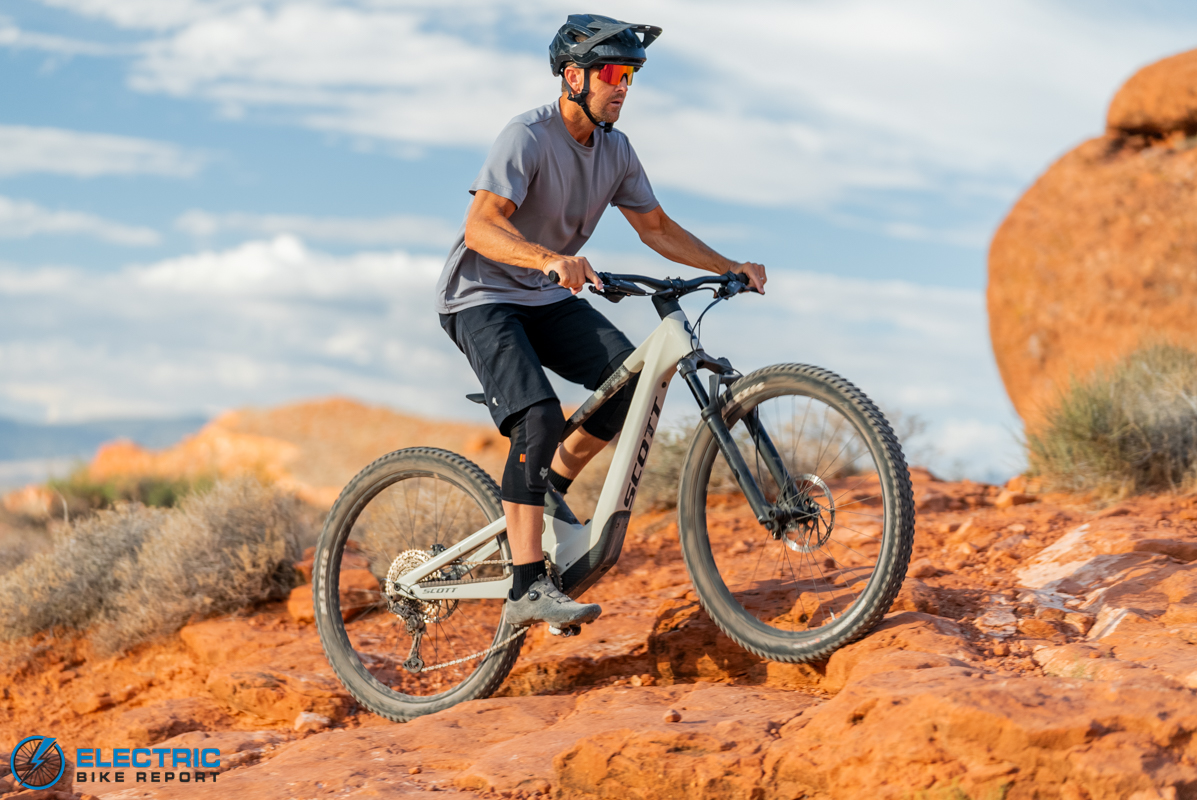
It’s used ad nauseam in e-bike reviews, but we mean it when we say this feels remarkably like a non-electric bike. Light and natural-feeling assist make it a unique riding sensation.
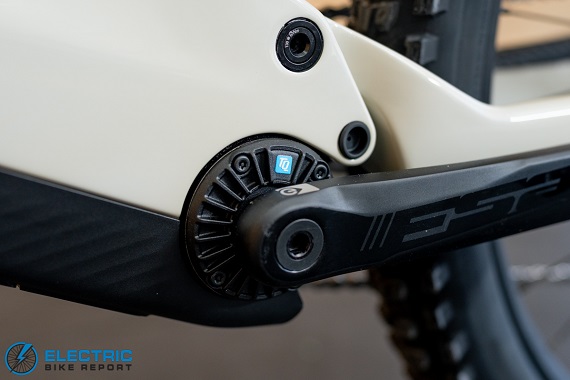
The TQ HPR50 motor is one of the quietest and compact on the market, period.
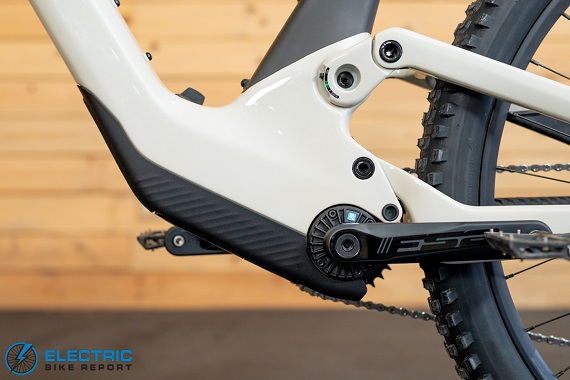
The Bottom bracket area is a little bulky, but overall, it’s quite clean, thanks to the concealed shock, and the rear linkage still features a sag indicator.
Scott Voltage Review: Motor & Battery
TQ’s patented Harmonic Pin Ring technology trims away the bulk found in many mid-drives. Instead of gears or belts, it uses a double-tooth ring where multiple teeth engage at once, transferring force directly through a few precisely shaped parts. This design keeps the motor compact, efficient, and whisper-quiet, with fewer moving pieces to wear out over time.
Plenty of drive systems deliver more raw punch, but that’s not the HPR50’s goal. Its strength is how naturally it blends with your effort—like a gym spotter giving just enough help on a heavy rep. You still put in the work, yet it smooths hill climbs and keeps you accelerating without losing the feel of a traditional ride. Among the motors we’ve tested, it’s one of the most silent and lifelike compared to non-motorized experiences, yet it doesn’t feel sluggish either. Riders wary of e-assist will appreciate how it maintains their usual heart-rate zone while adding speed and support.
Response to rider input is excellent once you find its preferred cadence, rewarding smooth spins with quick acceleration and confident climbing. We do recommend swapping the 175mm cranks for something shorter to more quickly spin the pedals.
Efficiency is another highlight: in our tests, it sipped energy compared with other systems, stretching the modest 360 Wh battery further than you’d expect. That battery hides cleanly inside the downtube, helping the Voltage keep its featherweight profile—motor and battery together add only about eight pounds to the 41.5-lb build.
The trade-off for such stealth is that the battery isn’t user-removable. It can still be swapped or serviced by a shop, but it limits quick DIY changes that some riders prefer. For those prioritizing low weight, quiet assist, and a barely-there look, though, this setup hits the mark.
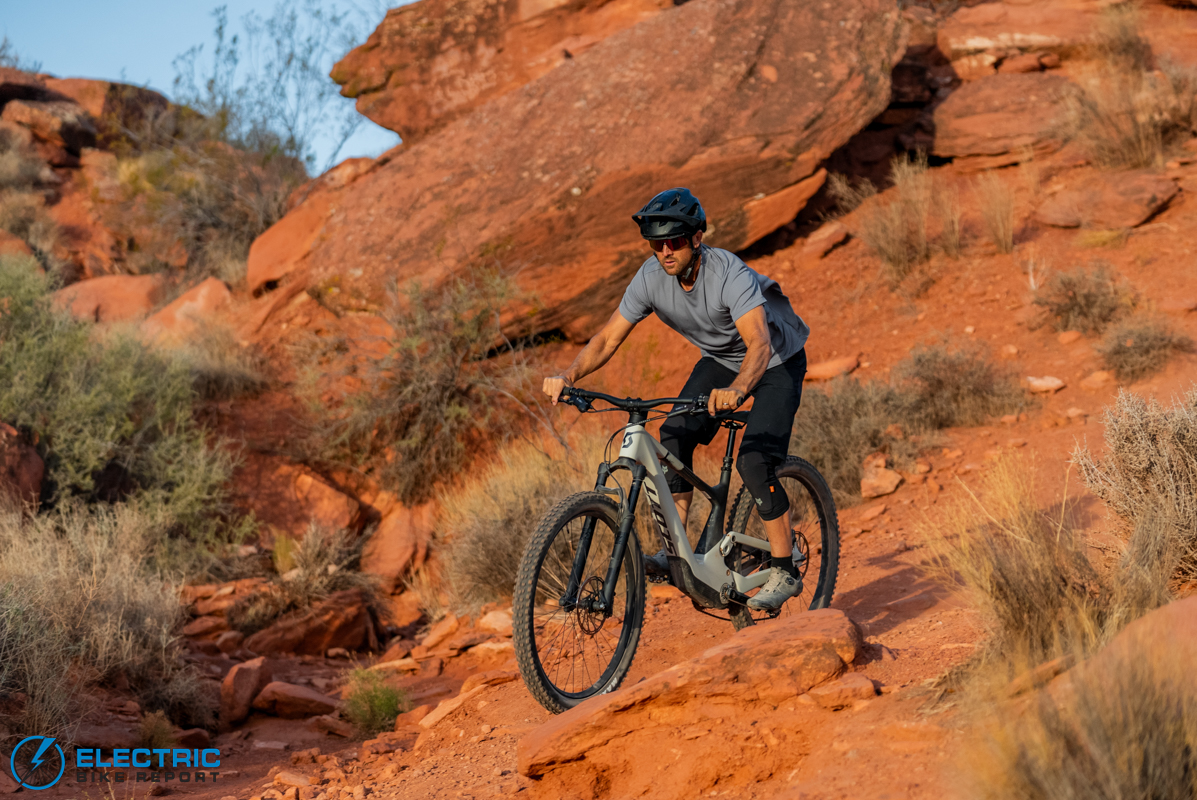
The Voltge eRide feels really confident and planted across technical descents.
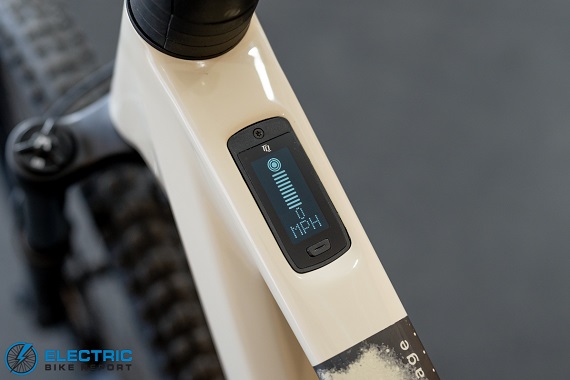
The monochrome display sits in the top tube and shows all the essentials you need for a quick glance.
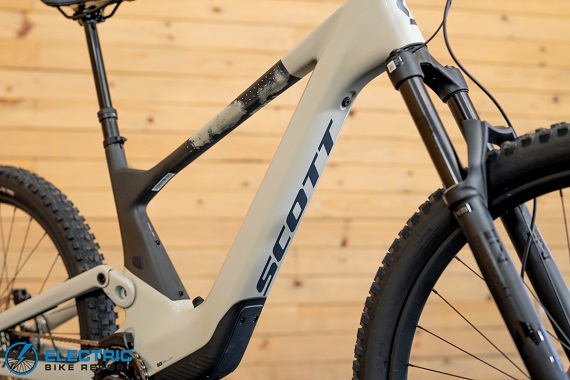
The downtube doesn’t seem very large, but its still packing in a 360Wh battery.
Scott Voltage Review: Display & App
The Voltage eRIDE 920 keeps its minimalist vibe when it comes to controls and data. TQ went for clean simplicity rather than layers of menus and options.
The monochrome display sits flush in the top tube, offering an understated look. A battery bar runs along the screen, while expanding circles indicate your assist level. With a quick toggle you can view state of charge (in percent), estimated range, speed, power, and a few other basics—no clutter, just the essentials.
TQ’s companion app mirrors that same focus. It can turn your phone into a larger display for the same key metrics if you mount it to the handlebar, or you can stick to the apps tuning tools to adjust Eco, Mid, and High modes. You’re able to tweak power output in watts, overall assist, pedal response, and even top speed. (At 235 lbs, I bumped up Eco for more punch, but Mid and High worked well as-is.)
Beyond tuning, the app hosts manuals, FAQs, and ANT+ connectivity for pairing a bike computer or sports watch—handy if you want to sync heart-rate or ride data with your other fitness tools
Scott Voltage Review: Range Test
We run all of our eMTB range tests on a dedicated loop that blends green, blue, and black singletrack. Because riders prefer different assist levels, we test exclusively in the highest power mode to establish a consistent “floor” value.
With just a 360 Wh battery—now the smallest we’ve tested—the Voltage eRIDE 920 still put up an impressive result. It covered 18.3 miles while climbing 1,339 feet. That makes it one of our shorter ranges overall, but context matters: its efficiency stood out.
The Voltage used only 19.7 watts per mile, compared with our eMTB average of 25.6. Paired with the motor’s 300 W max output, the system doesn’t waste energy, stretching the battery’s modest capacity. Expect roughly an hour and a half of riding at full power, which is solid for a pack this size.
Battery draw was noticeably steeper on long climbs than on flatter terrain. The assist kept us moving at a brisk pace everywhere, but you’ll see slower drain on rolling or cross-country routes. We didn’t stiffen or lock out the suspension with Scott’s TwinLoc feature (to keep testing conditions fair), though using it could help on extended climbs.
For riders needing extra mileage, TQ’s 160 Wh range extender bumps total distance to around 26.4 miles based on our data. It will take the place of one of your bottle cages, but you’ll still have room for a 500ml bottle from the secondary one.
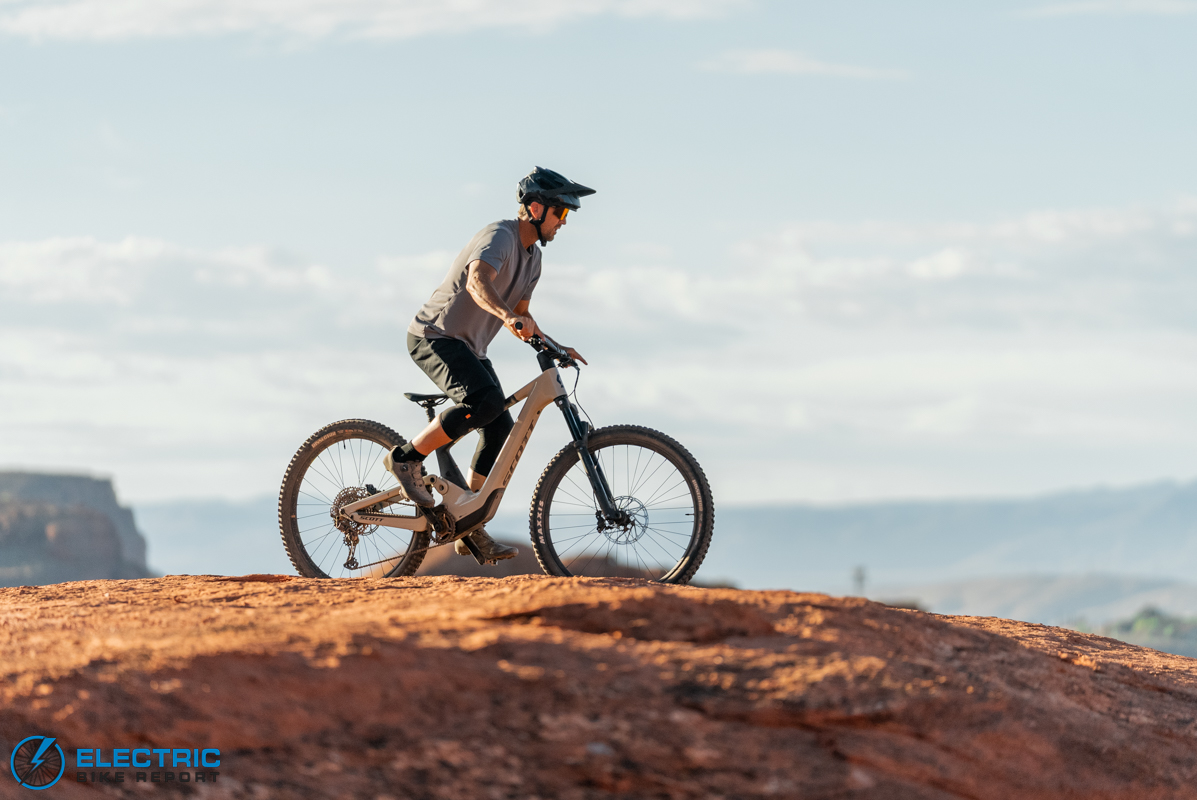
A trail bike with some all-MTN potential too, the Voltage is a well-rounded approach and does a little of everything well.
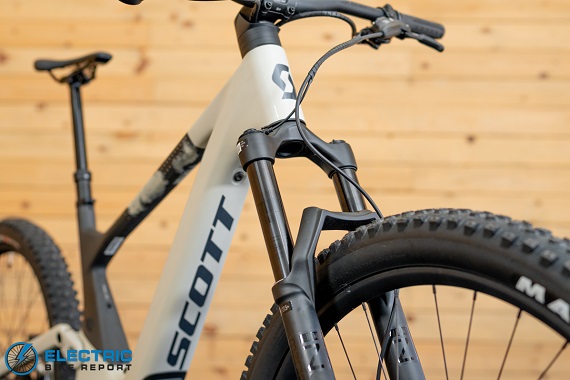
Another styling detail we enjoyed was the blacked-out look of the fork.
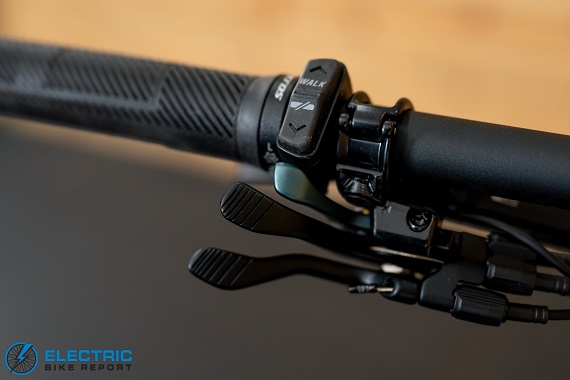
The Twin Loc system adds a few levers next to your dropper post, but lets you firm up or lock out suspension on the fly for max efficiency and changed up handling.
Scott Voltage Review: Hill Test
We put the Voltage through two climbs: our paved Devil’s Backbone hill (used for every e-bike we test) and our eMTB-specific Water Tower dirt climb.
- Devil’s Backbone: 2:53 to the top, averaging 10.5 mph
- Water Tower: 4:44 to the summit, averaging 11 mph
As expected, both results fall on the slower side compared with our eMTB averages of 2:09 and 3:36, respectively.
That doesn’t mean the motor is lacking. High-power eMTBs dominate headlines—and they’re a blast—but the HPR50 is built for a different goal: a ride that feels natural, even on hills. You’ll likely outpace any analog rider up these grades, yet finish feeling like you expended the same effort. That’s exactly the experience TQ set out to create. That’s what makes the Voltage a natural pick if you want to reclaim a step you’ve lost, or if you’re a newer mountain biker keeping up with a pack of experienced analog friends—this can be the equalizer without handling sacrifices of heavier full-power eMTBs.
Of course, if you want big-hit torque for steep, sustained climbs, the Voltage may not be your match. But for riders who just want a modest boost—especially on rolling trails or smaller hills—it’s ideal. The assist blends seamlessly with your cadence rather than overwhelming it, letting you climb the way you always have, just a bit faster.
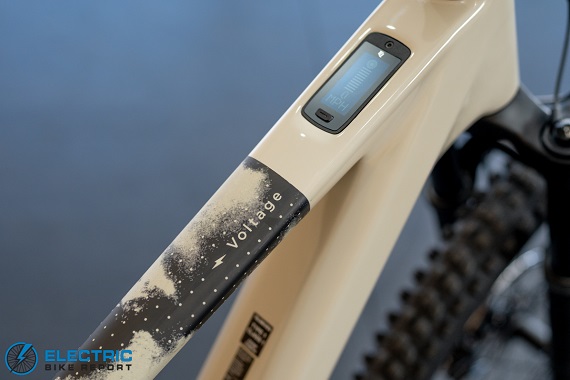
The Carbon frame is terrific, and while you don’t get frame options, there’s nice style built-in.
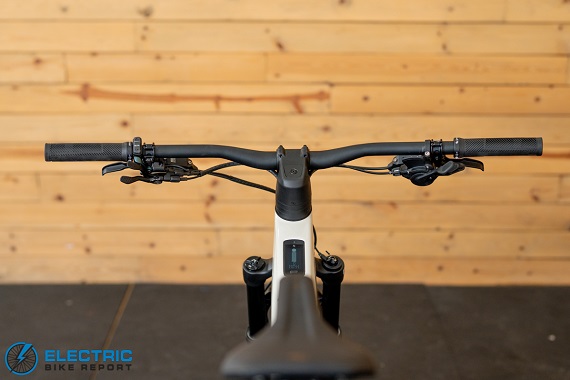
The 780mm handlebar aids with stability, and the cable routing through the headset minimizes cables.
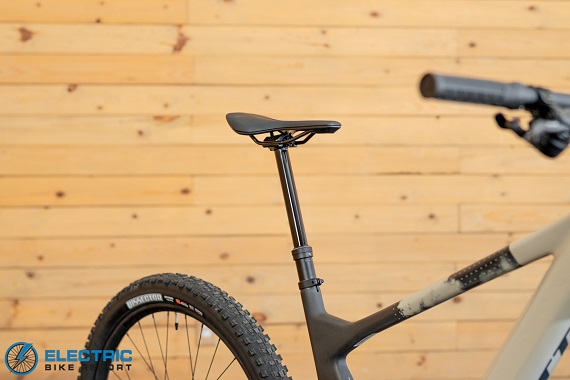
Scott sized up on the dropper post. We loved seeing 210 travel on a L frame!
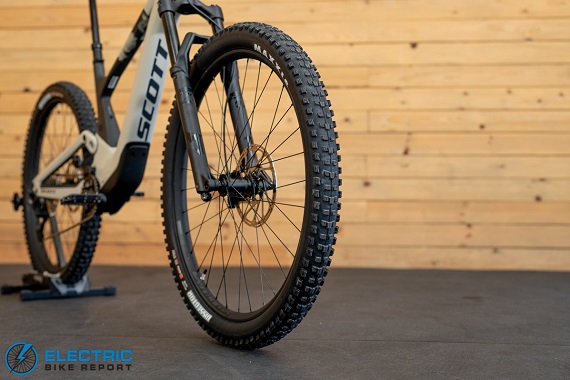
Maxxis tires are reliable performers across rooty forests or sandy deserts.
Scott Voltage Review: Ride Quality
Scott nailed the geometry here. As a Trail or All-MTN-category bike, the Voltage offers adjustable headset cups so you can choose between a steeper 65° head angle for quicker steering or a slacker 63.9° for more confident descending.
Its longer 455 mm chainstays keep it stable and planted at speed, though they trade away a bit of agility in tight switchbacks—especially with dual 29” wheels and no mullet option. The bike really shines on flowing or wide-open trails where you can lean into turns without fighting the chassis.
Fit and cockpit details are on point: a generous 780 mm handlebar inspires control, and the upsized dropper posts (S: 140 mm, M: 180 mm, L/XL: 210 mm) deserve a shout-out.
Weight is another highlight. At just over 41 lbs, the Voltage feels light for an eMTB yet still substantial enough for rocky descents giving you a solid base beneath. Compared to 50+ lb competitors, it’s refreshing to hop on something this nimble—and easier to sail into jumps.
Suspension performance matches the bike’s character. The Marzocchi Z2 Air fork is supportive with straightforward compression tuning, while the FOX Float Custom EVOL shock pairs well out back. Scott’s TwinLoc system lets you toggle Descend, Trail, or Lockout modes on the fly. I’ve been skeptical of TwinLoc on eMTBs (my wife’s Scott has it), but I think I’m starting to come around to it—it helps conserve energy on climbs or flowy sections, while opening fully for chunkier terrain, all without having to stop and fiddle with anything you just adjust on the fly.
Scott cleverly integrated the rear shock with an easy-to-read sag guide in the rocker link. Pop off the lower cover to access the valve when you need to adjust air pressure.
Component spec is solid for the 920’s price point. Maxxis Dissector 2.6” tires offer good grip and rolling speed across varied terrain. SRAM DB8 four-piston brakes provide confident stopping power, and the Shimano XT 12-speed drivetrain is dependable—no urgent upgrades needed.
Aesthetically, the Voltage is one of the cleanest bikes out there: internal routing, a minimal display, and the hidden shock keep everything tidy and mud-free on a valuable component. If you rely on shop service, maintenance won’t be an issue. DIY tinkerers, though, should know the integrated layout can make home adjustments a bit tight.
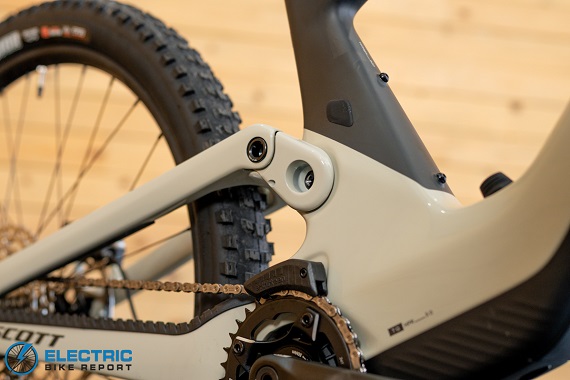
The rear shock is completely hidden, yet with 150mm of travel, it ensures a comfortable ride.
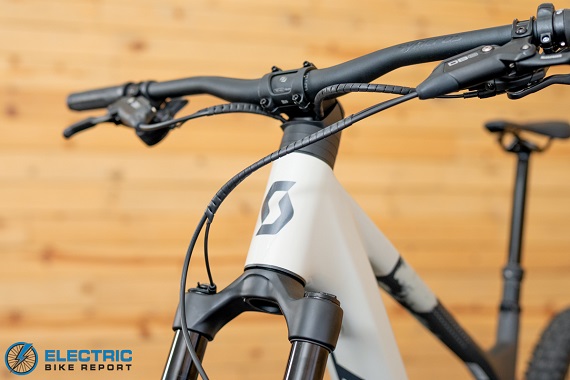
Not only does cable routing run inside the bike, but you can also adjust the headset cups to slacken out the ride or make it steeper for sharper handling.
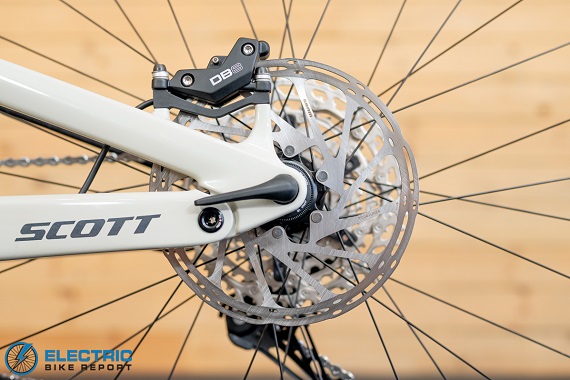
SRAM DB8 brakes worked reliably, and are a solid value at the Voltage’s price point.
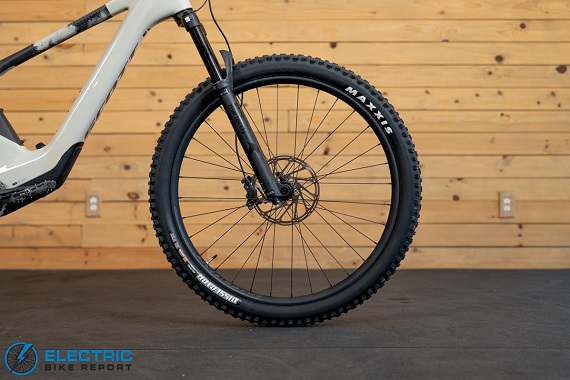
The Marzochi fork was more supportive than plush, but it performed nicely in our testing.
Scott Voltage Review: Summary / Where to Buy
The Scott Voltage eRIDE 920 delivers exactly what it promises: a light, stealthy eMTB that feels remarkably close to a traditional mountain bike. Only it isn’t—beneath that sleek carbon frame is a discreet motor that gives your legs a quiet boost, helping you climb higher and cover ground faster, while you exercise and get that heart rate up.
On the trail, the Voltage balances confidence and playfulness. It soaks up rough terrain at speed yet still pops easily over rollers and jumps. The spec is well-rounded, making it comfortable on everyday singletrack, winding switchbacks, and even the occasional downhill stretch. Enjoy the flow sections too—it’s a bike you can pop around on with no problem.
For riders hesitant about e-assist because they don’t want to lose the essence of riding they’ve come to appreciate, this bike is an ideal bridge. It preserves the feel of your favorite MTB while giving you just enough support to extend your rides and keep your best days within reach, or to start pulling away from your friends in largely a secret fashion—It’ll be hard for anybody to immediately spot as an e-bike.
Happy Riding! Make sure to let us know if you have any questions or if you think we left anything out in this review of the Scott Voltage down in our comments section.




Leave a Reply